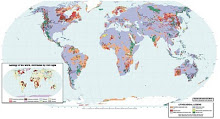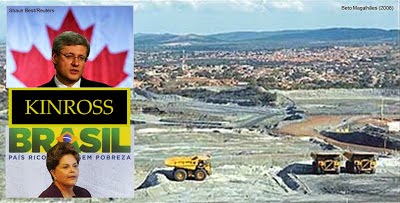Letter to World Bank's President, Mr. Robert B. Zoellick
To Mr. Robert B. Zoellick
President
The World Bank
1818 H Street, NW
Washington, DC 20433 USA
tel: (202) 473-1000
fax: (202) 477-6391
c.c.: World Bank Country Director for Brazil, Raid (UK), Mines and Communities, Mining Watch Canada, Friends of the Earth, International Society for Endangered People (GfbV, Germany), Okanogan Highlands Alliance, Movimento pelas Serras e Águas de Minas, Projeto Manuelzão, World Health Organization, Brazilian authorities, national and international media
Göttingen, June 30, 2009
Sir,
I am writing to You in your capacity as Chief Executive of World Bank *to ask for your immediate action to prevent an imminent catastrophe in Brazil*, which is to be brought about by the unwarranted expansion of a large-scale mining project, backed by the Minas Gerais State Government and a World Bank loan.
In 2008, World Bank signed a contract with the Minas Gerais state government by which this government will be loaned some US$ 1 billion until 2010. This was the first time World Bank conceded a loan directly to a Brazilian state without asking for any warrants but the achievement of certain agreed results.
In an interview, former World Bank director in Brazil John Briscoe appreciated this fact as “the first time in the bank’s 60 year history in which such a big loan is given to a sub-national entity”. Minas Gerais state governor Aécio Neves compared the loan to “a sign” of World Bank’s trust in Minas Gerais State, whose government will use the money to achieve, in several sectors, some “previously established goals”.
Now it becomes increasingly clear that one of these “previously established goals” is to set the stage for a real catastrophe.
Canadian Kinross Gold Corporation has been dealing with Minas Gerais State government authorities as early as 2004, when it bought 100% interests in the Paracatu Morro do Ouro Mine from the mining giant Rio Tinto.
In 2006, as Minas Gerais state governor Aécio Neves announced Kinross’ expansion project in Paracatu, he also made clear one of the goals of his government was “to attract some R$100 billion in investments until 2010, most of this amount being in the mining industry.”
Minas Gerais State secretary Wilson Brumer added to Mr. Neves statement: “Northwest Minas Gerais is a much important region. The Minas Gerais state government is going to invest very much in this region in terms of increase in energy offer, to match the region’s abilities in the mining and agriculture industries.”
In a second official announcement later in 2007, made in the presence of Kinross director Tim Baker, the same state secretary Wilson Brumer welcomed Kinross’ decision to invest in Paracatu as “a demonstration of trust in the Minas Gerais state.”
Having built an impressive track record in the mining industry and state agencies alike, Mr. Brumer was finally appointed to Kinross Gold Corporation direction board, as of May 2009.
As early as 2007 we have called the attention of the Minas Gerais state government agencies and people, *including governor Aécio Neves himself*, during one of his visits to Paracatu, to a large spectrum of evidence and facts that allow for the conclusion that *Kinross’ expansion project in Paracatu is worse than a crime, it is a blunder*.
Kinross plans to build a gigantic tailings impoundment on top of three important springs of an aquifer which constitutes the ultimate affordable resource of public water supply to Paracatu, a 90,000 inhabitants,
historical town in northwestern Minas Gerais state, 200 km S. of Brasilia-DF.
The 1.2 million tons of arsenic to be released by the expansion of the Morro do Ouro mine by Kinross will sum up with some 0.3 million tons of arsenic that have been already disposed in the first tailings impoundment. This unbelievable amount of 1.5 million tons of arsenic is a dreadful hazard that must be avoided.
As already shown by several reports, including the 2001 *United Nations Synthesis Report on Arsenic in Drinking Water* (quoted in the attached fact sheet, along with other serious evidence), a substantial part of that arsenic shall slowly and persistently spread over a large area in the São Francisco river basin, causing arsenicosis and cancer to millions of people during the coming years, decades and centuries.
The São Francisco river and its basin play a key role to the development of Brazil. The São Francisco is the only river that crosses the semi-arid Northeast part of the country without drying up. Its waters shall convey
life and wealth, not death and plight. Lots of national and international money and time, and entire lives of dedicated people have been invested in the development of the region. Now all these efforts are being jeopardized by a single mining project that threatens the region with mass poisoning.
*We take into account that World Bank considers it as inconvenient to have its name involved as a contributor to the environmental degradation of a city’s water resources and the plight of a whole region, even though World Bank would not admit direct responsibility for the potential chronic
poisoning by arsenic of thousands of people**. *
* *
In 2003, an independent review commissioned by the World Bank (the
Extractive Industries Report, EIR, released November 25), recommends steps
forward in regulating the mining industry, recognizing local people's rights
and implementing “best practice.” **
However many organizations such as Friends of the Earth International believe that the World Bank should withdraw from large-scale mining altogether: “Development finance should instead be used to support job transition, mine closure, reparations payment and alternative solutions such as re-use, recycling and reducing consumption.”
In view of the situation you may think it desirable to have more permanent contact maintained between World Bank, the Minas Gerais state government and the organized Paracatu community *in order to provide financial support to encourage the immediate closure of the Paracatu mine and the obligatory socio-economical and environmental restoration of Paracatu.*
This could be achieved through World Bank’s support in a number of community-based actions:
1. One restoration action should be to set up and fund a comprehensive water production programme for the whole Serra da Anta System, including the Machadinho Valley. This might be accomplished through a concerted action starting with the recognition of the 50,000 hectare Serra da Anta System as an area of public interest for water supply and the conservation of natural resources and endangered people and cultures. This is precisely the aim of the so called “Paracatu Waters Law”, under scrutiny by the Paracatu City Hall.
2. Another restoration action should be to fund long needed infrastructural, scientific, technological and educational projects in Paracatu including: (i) the sanitation and ecological restoration of the Rico Creek and all its tributaries within the urban settlement area, as a counterpart to the unwarranted, incomplete and damaging Kinross’ actions on this creek; (ii) the set up of institutional programmes on environment monitoring, comprehensive health surveys, and scientific and technological education and training for sustainable development.
3. Further development financing should be provided to support job transition during mine closure, reparations payment and alternative solutions such as re-use, recycling and reducing consumption.
All these actions should be aimed at resetting Paracatu town as a green town.
Sir, we appeal to your relevant and decided acting in this issue. It is necessary to take urgent steps. Owing to suspensions of the preliminary verdicts in two public lawsuits, we expect that Kinross will be given an installation permit by the Minas Gerais state government for the new tailings impoundment at any time. Failure or delay to action will cause irreversible damage and will set the stage for a catastrophe.
Yours Sincerely,
Sergio Ulhoa Dani, Dr.med., D.Sc.
President of the Acangau Foundation (Paracatu-MG, Brazil)
srgdani@gmail.com
www.alertaparacatu.blogspot.com
www.acangau.net
Sunday, October 11, 2009
Subscribe to:
Post Comments (Atom)




No comments:
Post a Comment